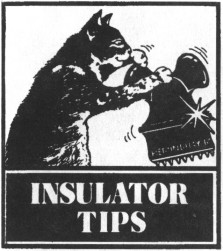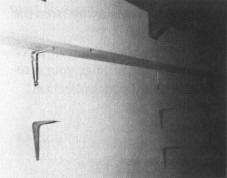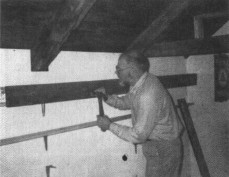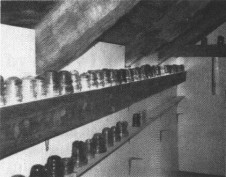Exhibiting Your Insulators At Home
by Larry Larned
Reprinted from "Crown Jewels of the Wire", April 1991, page 20
Are you faced with where to store your collection? Or how to display it? One
way is to leave it in boxes -- not much fun. Another way is to spread it on the
floor -- hard to see and easy to step on. Or another way is to place pieces all
over the house on window sills, dining tables, kitchen counters, toilet tank
tops, beside tables -- tough to know what's what and where a particular piece is. So, what to do?

I've been faced with this question since 1952 when
A.T.&T. cut the poles and let 'em drop on a major open wire toll line which
ran through the woods on my folk's place in Westchester County, N.Y. Of course,
I saved the insulators!
Over the past 25 years I've seen insulators displayed
many different ways -- at shows and at home. My preference? Lighted shelves done
in a tasteful way. I prefer the natural look for displaying insulators and for
women too! Let's face it, insulators were made for use in their natural
environment, reflecting light from all directions. And not everybody has enough
window space to exhibit their collection in natural sunlight. Somehow apples
have a greater appeal on the tree than in a bowl. So be it for insulators.
Considering all of these thoughts, I decided to share with you a recent project
for building lighted shelves -- good winter time project. First, consider what
you want to display -- maybe all the models don't qualify. Then locate a wall
which "needs shelves" and can support a heavy load -- these beauties
weigh at least 1 lb. a piece and some can be downright hefty (CD 331). Second,
consider what insulators you may collect in the future (almost impossible) and
plan your shelving needs accordingly. Third, consider your zone of greatest
visual acuity (step aside Dr. Ruth) and plan to place a shelf within this zone.
Usually this is about eye level. Certainly not at the ankles and not eight feet in the
air. Fourth, consider and appropriate length of shelving for the wall you plan
to use -- keep proportions in mind. Fifth, be sure to allow enough space between
shelves. Spacing must include the shelf thickness, the fixture height with
tube, the glass shelf above the tube and the average height of insulators in
your collection plus two inches.
Lighted shelves have the advantage of providing
vertical illumination with the bottom of each insulator only a fraction of an
inch from the light source -- only the glass shelf separates the two.
Now on to
construction. This separates the doer from the planner! Use materials readily at
hand and avoid spending a fortune -- after all what's more important --
obtaining
more insulators or investing in fancy shelves? For my purposes I chose 12 foot
shelves of No. 2 pine (1" x 4" which actually measure 3/4" x 3-1/
2"). And now to the foundation work -- this is important. Using a
stud finder or small nail, locate the studs or wall supports. Every second stud
should support a metal wall shelf bracket which in turn will support the
insulator shelf unit.

Consider where you want the shelf to be and working from
left to right place a pencil mark on the wall where the closest stud is located
to the shelf's left end. Now measure from this mark the length of the shelf you
plan to use and search for another stud. The shelf can overhang the end
supports a foot if need be. Now put a mark on the wall where the closest stud is
located to the shelf's right end and at the same height as the left mark.
Terrific, we have the end points!
I chose 5" x 4" pressed metal
brackets for the shelves. Although made of lighter gauge metal than solid steel,
they don't rust and their cross section is actually stronger and more elastic.
The metal brackets should be fastened to the wall studs using 1-1/2" steel
wood screws (no nails). Next fasten all the brackets to the wall. Now its
decision time again and a matter of personal taste. A fascia board will need to
be nailed to the wood shelf in order to hide the light fixture and to support
the glass shelf. I chose 1" x 6" weathered barn board -- the grays
complement my collection of SCA and purple glass. Prior to nailing the fascia
board to the wood shelf every 18 inches, tack a length of 3/8" x 1-1/2" lath onto the back of the fascia board just a 1/4"
below the top edge. This will support the glass shelf. At this time, also tack a length of lath to the
wall -- placed so that
when the wood shelf and fascia board are in place, the tops of the laths are
parallel. Now place the shelf unit onto the metal brackets making sure the shelf
is level. Use 1/2" wood screws to fasten the bottom of the shelf to the
metal brackets. Great job -- but the best is yet to come!

I used 4' single tube
fluorescent light fixtures -- three to a shelf and ganged together with a single
wire to a plug. Just place the fixtures on the shelf and plug into the wall outlet
to test the lamps. If they light -- great! Go on to the next step: the glass.
This
is a little tricky hut not hard. I used single strength window glass cut at my
local hardware store in three foot lengths. The important dimension is the
width. With the wood shelf and fascia board in place, measure the distance from
the wall to the back of the fascia board at one foot intervals over the total
length. If all the measurements are the same -- fine. If not, figure an average.
Allow an additional 1/8" to the glass width -- why? Because when the shelf is
fully loaded -- the lights, window glass and insulators -- some deflection will
occur and the fascia will move slightly to accommodate the load. The glass should
be snug when placed between the wall and the fascia board. As a finishing touch,
place a tie wire at each end of the fascia board using screw eyes and picture
wire: one eye in the wall stud and the other in the fascia board. The wire is
tied between the two eyes and prevents the fascia from moving away from the
wall.

Now with everything in place turn on the lights, arrange your insulators
and enjoy your collection!
| 